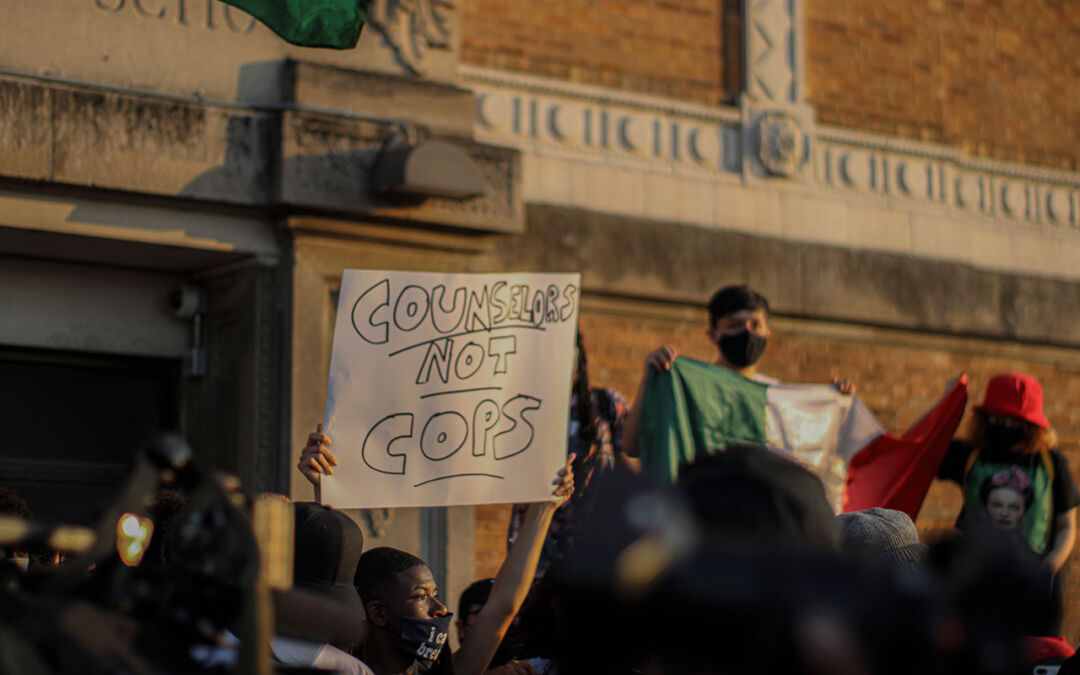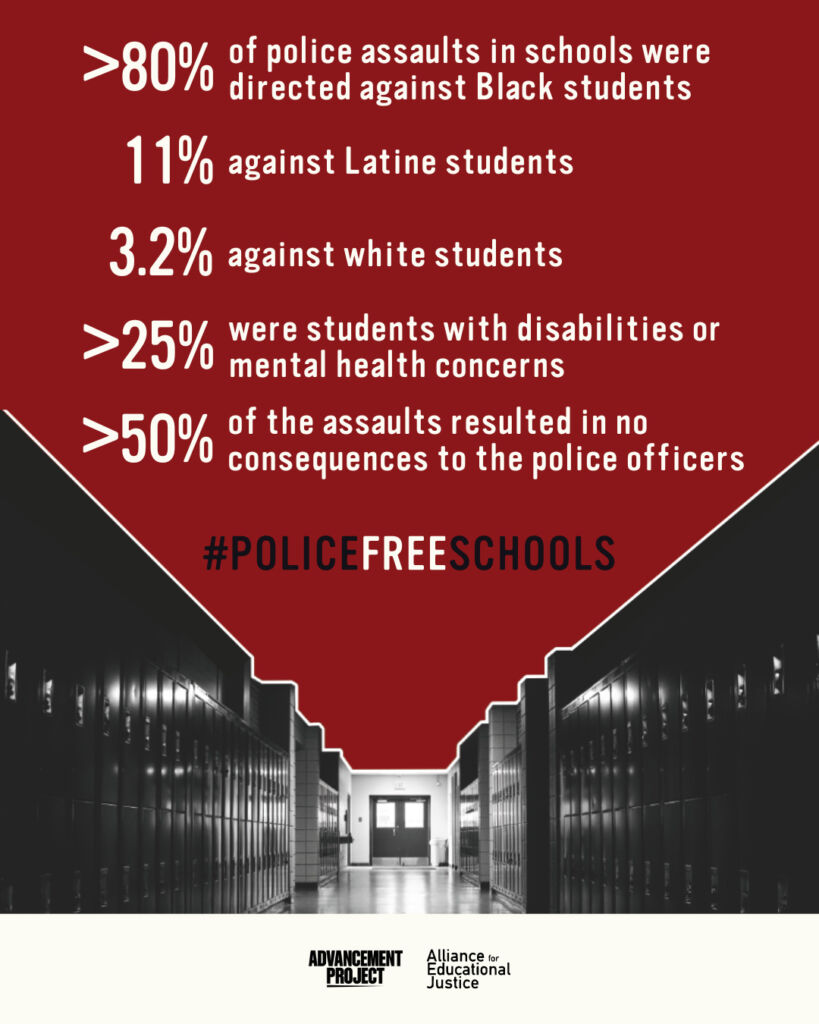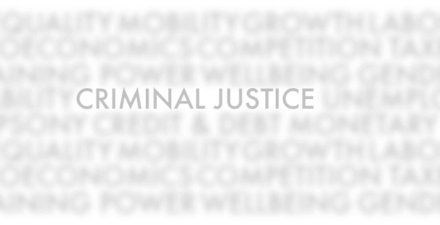Police in public schools harm students, leading to far-reaching socioeconomic inequalities alongside less safe schools

This column is the third in a series by guest authors examining systemic racial, ethnic, and gender inequities in the U.S. economy and in access to government social infrastructure and income support programs—inequities that hinder the full growth potential of our economy and the well-being of our society.
Assigning local police forces to U.S. public schools harms students economically, academically, and socially—especially Black students and other students of color. A large and growing body of data-driven research demonstrates that the misperceived benefits of what is essentially school security theater masks the far-reaching, long-term harmful consequences of empowering police in educational settings.
Such school policing is both ineffective at making schools safer, and is a primary driver of the school-to-prison pipeline—a web of policies and practices that directly and indirectly push students out of school and onto a pathway to the youth and adult criminal legal systems. School policing compounds the systemic underinvestment in other areas of public school education in disadvantaged communities.1 Recent research details how placing police in schools increases exclusionary discipline.2 School policing also leads to more student arrests for minor behaviors 3 while reducing instructional time,4 lowering student attendance5 and impacting on-time graduation rates.6
This body of research more specifically demonstrates that students who are arrested at school face a series of collateral consequences that harm their futures, their families, and their communities, including:
- The loss of instructional time and course credits
- Unnecessary and unwarranted court fees and legal costs
- Family separations
- Emotional and physical trauma
- Challenges to some students’ immigration status
- The loss of housing assistance
- The loss of employment and unemployment opportunities.7
This body of research also demonstrates these economic, social, and educational disruptions make it more likely that students in schools where police are present will enter the criminal legal system as an adult.8 That likelihood, in turn, helps uphold the socioeconomic inequities determined by race and ethnicity and the status quo harms of mass incarceration across the United States.9 This school-to-prison pipeline is a feature of the U.S. criminal legal system, and helps explain part of the growth in incarceration and its deleterious impact on people of color.10
Our column details the research on these thoroughly preventable outcomes and the misplaced idea that law enforcement has a role to play in our nation’s public schools. In fact, there are actionable evidence-based practices conducted by trained professionals who can help students with the support and care they need to navigate both adolescence and an unprecedented global health crisis.
The impact of police in public schools on Black students
School policing also disproportionately targets Black students.11 Research continues to demonstrate that Black students are arrested at higher rates when police are present in schools.12 Research in the area of office referrals, suspensions, and expulsions in public schools shows that Black students are not receiving disproportionate school disciplinary consequences due to higher rates of misbehavior. On the contrary, Black students do not misbehave more than their White peers.13
Outcomes are even worse for Black girls in public schools. Research by the U.S. Department of Education shows that Black girls are four times more likely than their White peers to be arrested, three times more likely to be referred to police, and two times more likely to be physically restrained.14
Moreover, policing students at school is ineffective and costly. Research by the National Institutes of Health’s National Library of Medicine demonstrates that school police neither make schools safer nor avert school shootings.15 Instead, police in schools negatively affects these schools’ climate and student safety.16 Heavily policed school atmospheres can alienate and increase anxiety in students, create a sense of mistrust between peers, and result in adversarial relationships between students and school officials.17
Nonetheless, local and state governments, as well as the federal government, continue to spend millions of dollars on the school policing infrastructure. This includes school police officer salaries and benefits, weapons, surveillance technology, and expensive monetary settlements following instances of excessive force and abuse perpetrated on students by police in schools. Between 1999 and 2019, state and federal governments invested close to $2 billion on school police.18
Since the 2018 mass shooting at Stoneman Douglas High School in Parkland, Florida and the passing of the federal STOP School Violence Act, many states have begun their own school police grant programs to the tune of hundreds of millions more dollars for school police.19 This allocation of funding toward police comes in contrast to years of budget cuts to education spending in school districts across the country.
Placing police officers in schools also creates a significant threat to the physical and emotional safety of Black students and students with disabilities. A new study by one of the authors of this column and his co-authors finds that of the 285 instances of school police officers physically and sexually assaulting students between the years 2011 and 2021, more than 80 percent of the victims of police assaults at school were Black students. Additionally, more than 25 percent of police assaults were on students with disabilities or students with reported mental health concerns.20
Black girls in particular were vastly overrepresented at nearly a third (30.7 percent) of all reported police assaults against students. Similar to the lack of police accountability that sparked protests following the murders of Mike Brown, Breonna Taylor, and many others, this study also finds that the offending officers suffered no consequences in well over half of the incidents. (See Figure 1.)
Figure 1

New police surveillance technologies in schools only make matters worse
Placing police in school and the growing trend of student surveillance merely creates the illusion of safety and security. There is no actual peer-reviewed evidence on the efficacy of surveillance measures being implemented in schools, including student device and social media monitoring, facial recognition, and weapons abatement technology. Instead, studies show that these technologies are flawed, and in many cases, simply do not work.21
What’s more, government surveillance chills free speech in public schools.22 Similar to the disproportionate impact of police in schools, these new surveillance technologies place students of color, students with disabilities, and LGBTQ+ students at greater risk of harm, including exclusionary discipline and increased contact with law enforcement.23
Policies that are effective at promoting safety and care in public schools
Students need support and care as they attempt to navigate both adolescence and an unprecedented global health crisis. School police are incapable and ill equipped to meet students’ social, emotional, and mental health needs in this moment.
Instead, students’ needs should be met by implementing proven, evidence-based practices performed by individuals trained to support young people. These trained individuals include restorative justice practitioners, counselors, mental health practitioners, and other qualified support personnel who are regularly trained in trauma-informed, youth-centered practices.
In short, the treatment of student trauma requires holistic student support services that address the root causes of the issues students are facing, not policing or criminalization.
Ultimately, to achieve school safety and foster nurturing learning environments, school leaders and policymakers must implement strategies that create cultures of care that seek to prevent and repair harms, while also teaching students and staff how to be accountable for their actions.
—Tyler Whittenberg is deputy director of the Opportunity to Learn Program at the Advancement Project. Jessica Alcantara is senior staff attorney for the Opportunity to Learn Program at the Advancement Project. For more information about the national campaign to remove police from schools, visit www.policefreeschools.org.
End Notes
1. Jesse Rothstein, “Equal access to a good education is not just about sound school budget,”(Washington: The Washington Center for Equitable Growth, 2007), available at https://equitablegrowth.org/equal-access-good-education-not-just-sound-school-budgets/.
2. Benjamin W. Fisher and Emily A. Hennessy, “School Resource Officers and exclusionary discipline in U.S. high schools: A systematic review and meta-analysis,” Adolescent Research Review, 1 (2016): 217–233, available at https://ed.buffalo.edu/content/dam/ed/safety-conference/Fisher%20%26%20Hennessey%20(2016).pdf. See also Emily K. Weisburst, “Patrolling Public Schools: The Impact of Funding For School Police on Student Discipline and Long-Term Education Outcomes,” Journal of Policy Analysis and Management, 38 (2) (2019): 338–365, available at https://onlinelibrary.wiley.com/doi/epdf/10.1002/pam.22116.
3. Emily G. Owens, “Testing The School‐To‐Prison Pipeline,” Journal of Policy Analysis and Management, 36(1) (2017): 11-37 available at https://escholarship.org/content/qt0b8976wk/qt0b8976wk.pdf.
4. Daniel J. Losen and Paul Martinez, “Is California Doing Enough to Close the School Discipline Gap? The Center for Civil Rights Remedies,” (Los Angeles: The Civil Rights Project at UCLA, 2020), available at https://www.civilrightsproject.ucla.edu/research/k-12-education/school-discipline/is-california-doing-enough-to-close-the-school-discipline-gap.
5. Kevin P. Brady, Sharon Balmer, and Deinya Phenix, ”School-Police Partnership Effectiveness in Urban Schools: An Analysis of New York City’s Impact Schools Initiative,” Education and Urban Society, 39 (2007): 455-478, available at https://www.researchgate.net/publication/237564796_School-Police_Partnership_Effectiveness_in_Urban_Schools_An_Analysis_of_New_York_City%27s_Impact_Schools_Initiative.
6. Weisburst, “Patrolling Public Schools: The Impact of Funding For School Police on Student Discipline and Long-Term Education Outcomes.”
7. Sue Burrell and Rourke F. Stacy, “Collateral Consequences of Juvenile Delinquency Proceedings in California: A Handbook For Juvenile Law Professionals,” (California: Pacific Juvenile Defender Center, 2011, available at https://www.courts.ca.gov/documents/BTB24-4D-9.pdf.
8. Brent B. Benda and Connie L. Tollet, “A Study of Recidivism of Serious and Persistent Offenders Among Adolescents,” Journal of Criminal Justice, 27(2) (1999): 111-126, available at https://psycnet.apa.org/record/2006-00160-003.
9. Washington Center for Equitable Growth, “Race & Ethnicity,” available at https://equitablegrowth.org/issue/race-ethnicity/ (last accessed April 11,2023); Alix Gould-Werth, “What upticks in U.S. economic inequality and incarceration mean for marriage,” (Washington Center for Equitable Growth, 2018), available at https://equitablegrowth.org/what-upticks-in-u-s-economic-inequality-and-incarceration-mean-for-marriage/.
10. Robyn Cox, “Overcoming social exclusion: Addressing race and criminal justice policy in the United States,” (Washington Center for Equitable growth, 2020), available at https://equitablegrowth.org/overcoming-social-exclusion-addressing-race-and-criminal-justice-policy-in-the-united-states/.
11. E.M. Homer and B.W. Fisher, “Police in Schools and Student Arrest Rates Across the United States: Examining Differences By Race, Ethnicity, and Gender,” Journal of School Violence, 19, (2020): 192–204, available at https://www.safetylit.org/citations/index.php?fuseaction=citations.viewdetails&citationIds%5b%5d=citjournalarticle_643359_20.
12. Ibid.
13. Russell J. Skiba, “Reaching A Critical Juncture For Our Kids: The Need to Reassess School-Justice Practices, Family Court Review, 51(3) (2013): 380-387, available at https://onlinelibrary.wiley.com/doi/10.1111/fcre.12034.
14. U.S. Department of Education Office for Civil Rights, “2015-2016 Civil Rights Data Collection, School Climate & Safety,” (2018), available at https://www2.ed.gov/about/offices/list/ocr/docs/school-climate-and-safety.pdf.
15. Melvin D. Livingston, Matthew E. Rossheim, and Kelli Stidham Hall, “A Descriptive Analysis of School and School Shooter Characteristics and The Severity of School Shootings in the United States, 1999–2018,” Journal of Adolescent Health, 64 (2019): 797-799, available at https://pubmed.ncbi.nlm.nih.gov/30833119/.
16. Jason P. Nance, “Students, Police, and the School-To-Prison Pipeline,” Washington University Law Review, 93, 919 (2016), available at https://openscholarship.wustl.edu/law_lawreview/vol93/iss4/6/.
17. Kathleen Nolan, Police in the Hallways: Discipline in an Urban High School. (Minneapolis: University of Minnesota Press, 2011), available at https://www.upress.umn.edu/book-division/books/police-in-the-hallways. See also R.R. Beger, “The Worst of Both Worlds,” Criminal Justice Review, 28 (2003): 336-340.
18. Strategies for Youth , “Two Billion Dollars Later: States Begin to Regulate School Resource Officers in the Nations Schools. A Survey of State laws,” (2019), available at https://strategiesforyouth.org/sitefiles/wp-content/uploads/2019/10/SFY-Two-Billion-Dollars-Later-Report-Oct2019.pdf.
19. Intercultural Development Research Center, “Resource Center,” available at https://www.idra.org/resource-center/at-what-cost-a-review-of-school-police-funding-and-accountability-across-the-u-s-south/ (last accessed April 11, 2023).
20. Tyler Whittenberg and others., “#AssaultAtSpringValley: An analysis of Police Violence Against Black And Latine Students in Public Schools,” (Advancement Project & Alliance for Educational Justice, 2022), .https://advancementproject.org/resources/assaultatreport/.
21. Natasha Duarte et al. , “Mixed Messages? The Limits of Automated Social Media Content Analysis,” (Center for Democracy and Technology, 2017), available at https://cdt.org/wp-content/uploads/2017/11/Mixed-Messages-Paper.pdf; Amrita Khalid, “Facial Recognition AI Can’t Identify Trans and Non-Binary People,” Quartz (2019), available at https://qz.com/1726806/facial-recognition-ai-from-amazon-microsoft-and-ibm-misidentifies-trans-and-non-binary-people/; Human Rights Watch, “Facial Recognition Technology in U.S. Schools Threatens Rights,” (June, 21, 2019), available at https://www.hrw.org/news/2019/06/21/facial-recognition-technology-us-schools-threatens-rights; Mark Keierleber, “The Latest School ‘Weapons Detection’ Tech Can Miss Serious Threats, Experts Say,” The 74 (Jan. 30, 2023), available at https://www.the74million.org/article/the-latest-school-weapons-detection-tech-can-miss-serious-threats-experts-say/.
22. Karen Gullo, “Surveillance Chills Speech – As New Studies Show – And Free Association Suffers,” Electronic Frontier Association (May 19, 2016), available at https://www.eff.org/deeplinks/2016/05/when-surveillance-chills-speech-new-studies-show-our-rights-free-association.
23. Elizabeth Laird and others, “Hidden Harms: The Misleading Promise of Monitoring Students Online,” (Center for Democracy and Technology, 2022), available at https://cdt.org/wp-content/uploads/2022/08/Hidden-Harms-The-Misleading-Promise-of-Monitoring-Students-Online-Research-Report-Final-Accessible.pdf.







